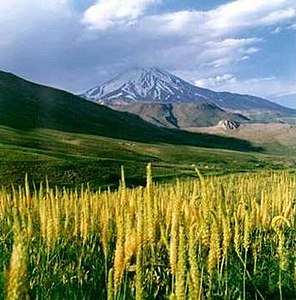Elburs Mountains
| Elburs | ||
|---|---|---|
|
Damāvand - the highest mountain in the Elbors Mountains |
||
| Highest peak | Damāvand ( 5604 m ) | |
| location | Northern Iran | |
|
|
||
| Coordinates | 36 ° N , 52 ° E | |
The Elburs , also Alburs and Albors (mountains) ( Persian البرز Alborz ), is a high mountain range in northern Iran between the Caspian Sea and the Persian Highlands , which towers over 5600 m high. The highest peak is the Damāvand volcano in the central part of the mountain near the Persian capital Tehran , which is directly adjacent to the southern slopes of the Elbur.
The Elburs extends in a west-east direction. It consists of several chains running parallel to each other and forms the southern border of the Caspian Sea, to which it slopes steeply. It is part of the Asian mountain system that stretches from the Armenian highlands via the Elburs and Kopet-Dag (on the border with Turkmenistan ), Sefid-Kuh , Koh-e Baba and the Hindu Kush (in northeastern Afghanistan ) to the Pamir . Within this almost 3,000 km long mountain system, the Elburs covers a total of 600 kilometers; it is between 60 and 130 kilometers wide.
places
- Bandar Anzali
- Rascht
- Qazvin
- Sari
- Bābol
- Tehran
- Karaj
- Masuleh
- Chalus
- Savad cow
- Shahmirzād
- Sangsar
- Gorgan
Winter sports resorts
Winter sports are possible due to the high altitude and the snowy winters. There are some well-known winter sports locations , especially in the area of the metropolis of Tehran: Dizin , Schemschak , Totschāl and Darbandsar .
Flora and fauna
On the north side of the Elburs Mountains there are large primeval forests of beech ( oriental beech ) and other deciduous trees, such as the endemic parrotia ( Parrotia persica ), which have only survived in this extent in the far east of the beech distribution area. The fauna includes bear and wolf , lynx and caracal , the smaller bobcat of Africa, fox and golden jackal , European wild cat and leopard , plus 30 species of eagles , falcons , buzzards and vultures . Larger herbivores include roe deer , the maral , a larger Asian relative of our red deer , fallow deer , ibex , chamois , wild sheep and wild boar . Even in the Middle Ages the mountain wisent lived there .
| Central part of the Elbursgebirge | Summit: | 1 Ālam cow |
|---|---|---|
| 2 Āzād cow | 3 Damāvand | |
| 4 Thu Berār | 5 Do Chāharān | |
| 6 Ghal`eh Gardan | 7 Gorg | |
| 8 kholeno | 9 More Tschāl | |
| 10 Mīschīneh Marg | 11 Nāz | |
| 12 Shah Alborz | 13 Sīālān | |
| 14 Tochāl | 15 Varavasht | |
| Rivers: | 0 | |
| 1 Alamut | 2 Tschālūs | |
| 3 Do Hezār | 4 Harāz | |
| 5 Jādj Rūd | 6 Karaj | |
| 7 Kodschūr | 8 Lār | |
| 9 No. | 10 Sardāb | |
| 11 Se Hazar | 12 Shāh Rūd | |
| Cities: | 1 µmol | |
| 2 Tschālūs | 3 Karaj | |
| Other: | D Dizin | |
| E Harāz Street | K Kandovān Street | |
| * Latyān dam | ** Lār dam |
Mythological and literary importance
The Elburs Mountains also play a role as a - not always precisely localized - place in Iranian mythology and are celebrated in Persian literature . It is already mentioned in the Avesta and several times in Firdausi's Shāhnāme , among other things as a place (located in "India") where the magical bird Simurgh had its nest and raised Zāl . In addition, the kings Fereydun and Kai Kobad , whom Rostam brought from there to Iran according to Firdausi, are said to have grown up under the protection of these mountains; Nowzar had his wife brought to safety in the Elburs in front of Afrasiyab and Kai Kawus had the Divs build two castles for himself here. The Damāvand, in which one saw the great, central world mountain of Zoroastrian legends and was chained to the Azhi Dahaka , is the subject of two poems by Mohammad-Taqi Bahar .
See also
- Caspian Hyrcania mixed forest
- Tangeh Sāvāschi , mountain gorge and excursion destination with rock relief from the Qajar period
- Zagros Mountains
- Kuhrūd Mountains
- List of mountains or elevations in Iran
Web links
- Elburs Mountains . In: Ehsan Yarshater (Ed.): Encyclopædia Iranica (English, including references)
Individual evidence
- ↑ Article Elburs Mountains in the Great Soviet Encyclopedia (BSE) , 3rd edition 1969–1978 (Russian)
- ↑ VG Heptner, AA and AG Bannikov Nasimovich: Mammals of the Soviet Union (Mlekopitayushchie Sovetskogo Soyuza) English edition. Volume 1: Artiodactyla and Perissodactyla. Smithsonian Institution Libraries and The National Science Foundation, Washington, DC 1988 (translated for the Smithsonian Institution by PM Rao, first published by Vysshaya Shkola Publishers Moscow, 1961), pp. 557-599
- ↑ Jürgen Ehlers (ed. And trans.): Abū'l-Qāsem Ferdausi: Rostam - The legends from the Šāhnāme . Philipp Reclam jun., Stuttgart 2002, p. 361
- ↑ M. Boyce: Article In: Iranica





